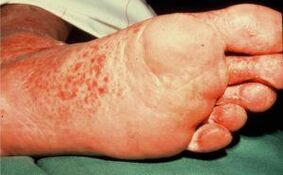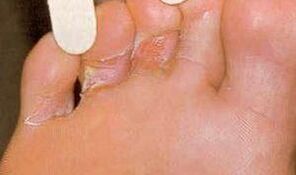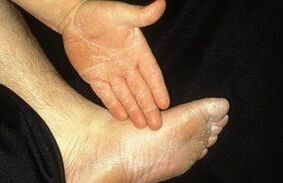Mikoz Stop is an infectious disease that is transmitted by a sick person to a healthy person, as well as by personal objects that a person with a used mushroom.Very often, the disease is transmitted during the visit to public places where they go barefoot.A hot and humid place is an ideal environment for long -term storage of the mushroom spores in a living state.That's why in the bathrooms, swimming pools and water parks you can't walk without shoes.
Ways to infect with the mycosis of the stop

A person becomes contagious at the first appearance of external signs: dry legs, itching, peeling.The stairs that are separated from the dermis are contested by mushrooms and when a healthy person enters the skin, the infection is transmitted.The disputes are quite small, they cling to the intercellular space and begin to grow.The threads of Micelia are displayed, which cover more and more space.
At this moment, the patient cannot walk barefoot, as he becomes extremely contagious.A great way to suspend the spread of the disease between families is to wear cotton socks.
Where the infection occurs more often:
In saunas and bathrooms.
In the basins of water parks.
At the time of assembly shoes.
Through bed linen in a hotel or in an outpatient clinic.
When you visit the beach.
Foot mycosis infection does not always occur.In the same circumstances, a person may not "capture" the mushroom and the second will get sick immediately.This is explained by the power of immunity and other factors.It is noted that they get sick faster in the following circumstances:
Low immunity.
HIV, diabetes and other related infections.
Non -compliance with hygiene.
Frequent physical activity associated with excessive sweating.
Wear tight shoes.
Wearing synthetic clothes.
Hormonal problems in women.
Diseases associated with metabolism.
Frequent contact with chemicals.
Symptoms of foot mycosis
Foot mycosis is an unpleasant disease that not only does not seem aesthetic, but also causes unpleasant sensations.Determine for 100%, whether you are sick of mycosis or that you have eczema, allergies or other diseases, only tests carried out by sowing or Soskobom will help you.However, there are a series of signs with which the mushroom can be visually determined:
Excessive dry skin: the skin becomes dry, begins to detach itself, acquires a white or gray tint.
The itching is sometimes so strong that the patient embraces the skin, leading to additional injuries.
Pain.
The aspect of skin crisis.
Dry skin goes in the form of a movie.
Red points that merge over time.
The appearance of the plates.
An unpleasant smell - earth smell, mold.
When the skin is pressed, Otdelimoe Bianco may appear.
All these symptoms do not appear immediately, but gradually.The first sign can be the redness of the skin and itching, and after some time the remaining external events of the mushroom come together.
How the disease begins
The beginning of the disease proceeds one of the four types:

Scaly.The main sign in this path of development of mycosis is peeling and formation of dry skin stairs.
InterTrrigiosny is characterized by the presence on the skin of the outbreaks, externally similar to the rash.
Disghidrotheskiy is caused by diffunkciCionalnostu and the improved work of the sweat glands.
The onychomicosis affects, as a rule, nails on the legs.
In the squamous form of initial mycous, patients do not notice the appearance of the disease for a long time.The fact that the mushroom has been hit by the skin says only a slight redness and excessive dry skin, which masks the cream of ordinary legs.
The second type begins with the appearance of bubbles and rash, inside which the liquid is located.They can combine multiple bubbles, forming outbreaks at 5-8 mm.After some time, the ulcers appear in their place and the pain joins the existing symptoms.This is the most common way of the disease and very often affects the space of Megpalcevoe.
The type of Disghydrotheskiy has the following symptoms: there are cracks on the skin with a white edge, a constant increase in humidity instead of the location of mycosis, loosening the skin and severe pain.
With the onychomycosis, the nails suffer mainly.The color change, the growths appear and with an atrophic form: the stratification and thinning of the nail.The nail roller can get inflamed, the nails crumble and unstable in the nail bed.
Because it is the foot mushroom you need to treat
In the initial phase of the mushroom, not everyone is in a hurry to ask doctors for help, also avoiding the diagnosis itself.The first stage of mycosis usually proceeds painless, its symptoms can be canceled and few people pay attention to slight redness and excessive dryness.The racing phases of the mushroom are often found in men and the elderly.
However, mycosis is a disease that not only changes the appearance of the legs, making them less attractive.The mushroom of the feet with rapid development affects enormous areas of the skin, which start bleeding, covered with ulcers and erosions.A person can become completely defenseless, since in the initial phase it would seem, an harmless disease can completely deprive a person of the opportunity to walk.
But that's not all.The mushrooms that deposit on the legs secrete harmful substances and toxins in the process of their life, which act destructively on many organs and fabrics and also cause general poisoning of a person.If the foot mushroom is not treated, the following symptoms may appear:
Frequent headache.
Nausea.
Decrease or increase the pressure.
Weakness, decrease in performance.
Increase in anxiety.
In addition, the non -aesthetically appearance legs lead to stress in many women who begin to complete, to be shy to wear open shoes.In general, the mycosis of the feet are able to significantly worsen the quality of life of any person.
Stop mycosis phase
Like any other mushroom, mycosis, located on the legs, has 3 phases:
The initial phase or the first.
The average stage or the second.
Correct mushroom or third phase.

The phases of the mushroom are distinguished not so much at the time of the disease as for the percentage of the foot injury.Therefore, the mushroom, which occupies up to 10% of the foot, is attributed to the initial one.It can be treated easily and quickly also by local drugs.But if the defeat was more than 30% of nails or feet, they are already talking about an advanced phase.This phase is treated not only externally, but also with pills, while the probability that several treatment courses are required is exceptional.
Very often, patients with 2 and 3 phases of mushrooms are addressed to the doctor.In addition, in recent years, the number of cases has increased by 2.5%.Perhaps this figure indirectly confirms that people have started to be simply examined more often and trust traditional medicine.
Prevention of the mycosis of the stop
Mycosis prevention is relevant in two cases.It is necessary to continue the preventive measures after therapy for some time if the patient has not exceeded the analysis of the mushroom after recovery.This is a fairly serious infection that can return several times, especially if a person has not changed his lifestyle and has not freed himself of concomitant diseases.But a completely healthy person can get a foot mushroom if he does not follow the following rules:
Follow the rules of hygiene.This does not mean that it is necessary to wash with gel or soap every day 2 times a day - the washing too frequent with detergents destroys the external layer of the skin and the lipid barrier, due to which the infection is easier to implement in the dermis.
Do not allow excessive sweating.A warm and humid environment is ideal for the propagation of these microorganisms.
Eliminate metabolic problems, gynecological diseases and other chronic diseases.
Don't go barefoot in the pool, bathroom, general soul.
Having antimicrobial ointment in your home medicine cabinet and apply it to your feet every time if you need to spend the night in the hotel and you are not sure of the cleaning of the linen.
Grease in pressure shoes.The mushroom often begins with the thumb of the foot, since it is the one who most often suffers physical effects when he wears too small or narrow shoes.
Choose natural materials for socks and shoes.
If your foot mushroom is located in the house, for the patient it is necessary to highlight a set of linen, towel, slippers, separate slippers.They must be regularly sterilized by boiling and, in the case of manicure accessories, the alcohol treatment method.
Treatment
The mycosis of the foot must be treated.Typically, the doctor prescribes the treatment, choosing the appropriate algorithm based on the patient's condition, concomitant diseases, conditions and other characteristics of the disease stadium, a place of localization of the focus, such as fungal infection.
Complex treatment with pills
A complex treatment will help to obtain quick results, when, in addition to local drugs, tablets are prescribed.Depending on the active substance in drugs, the intake of the medicine can be multiple or once.Local treatment can quickly destroy the mushroom membrane, leading to its death.The complex treatment is considered the best solution when the mushroom spreads throughout the foot.
Local treatment
In the initial phase, when the mushroom has not spread in extensive areas and does not have a great negative effect through the Limfoticheskuyu system on the patient's condition, it is possible to cure it with local treatment.For this, pharmacists have developed different forms of drugs that should be applied directly to the Focus of mycosis:
Cream.
Ointment.
Dough.
Spray.
Solution.
Before applying the local drug, the skin should be prepared: washed and dried thoroughly.With onychomicosis of the legs, the nails are steam and cut the upper part of the nail plate.
Popular medicine and foot mushroom
Sometimes the foot mushroom can be treated by traditional medicine.Very often, the toilets of the feet are offered by a variety of components.For the bathrooms, they take vegetable materials: herbs herbs, raspberry branches, kidney kidney trees, oak bark and so on.However, there are more exotic recipes: they can contain grated soap, candor and other chemistry.
When using folk recipes, you should remember that they are not a mushroom panacea and do not always help.However, they perfectly face symptomatic treatment, removing the itching and healing of small wounds.
Clinical forms of mycosis of the stop
In the foot mushroom, it is also often called dermatofitiey or dermatomikosom.If the mushroom spread to the nails of the legs, then they speak of the appearance of the Wholenomicosis.The clinical forms of mycosis are also distinguished:
Inter mushrooms (it seems redness and hyperthermia with peeling between the fingers, is wet and dry, this is the most frequent disease with mycosis);
Hyperkeratosis (pathology in which excessive peeling and peeling of the upper layer of the skin of the feet affected by the mushroom occurs, the upper layer of the skin can go completely);
Dermatofidia (represents an allergic eruption that accompanies fungal diseases).In addition, this form is called allergic contact dermatitis complicated by mycosis.
The clinical form is determined by the dermatologist and prescribes adequate treatment.
The canceled image of mycosis

With a strong immunity, the initial phase of the mushroom can practically pay attention to itself for a long time.A little redness and peeling at the edges of the foot do not cause unpleasant sensations to the patient and the patient does not suffer a treatment in time, becoming a source of infection of many people.The canceled image of mycosis is a common phenomenon, but you must know what to pay attention to not losing the spread of the disease.With canceled symptoms, the mushroom resembles this:
The small redness, as a rule, is oval or formed along the foot.
Dry skin.
The appearance of cracks in the wake of yellow or whitish.
The aspect of unpleasant sensations when walking or sweat.
Small itching, which is quickly eliminated by washing the legs or cream.
The appearance of small furrows on nails or white spots.
The color of a large nail on the legs differs from the other nails.
All these signs rarely appear simultaneously with a clinic managed on the feet, however, even the appearance of 1-3 signs should serve as an opportunity to look for a doctor and make a diagnosis for analysis.
Humid mycosis
Wet mycosis is a complicated form of fungal infection.With a large focus of the foot mushroom and prolonged ignoring the disease, the microcracks appear to the place of the hearth, which over time expand, transforming into ulcers and erosion.They do not heal for a long time, they inflict pain and inconveniences to patients, sometimes patients cannot move alone for pain.Wet mycosis appears in places of the largest accumulation of sweat - between the fingers and their base.It is treated with antifungals and drying ointments, for example zinc.Various drying updates have proved well, for example a local antibiotic boneocine.
Wet mycosis is more often complicated by a bacterial infection.
Foot complicated mycosis
The mushroom destroys the upper layer of the dermis, opening the gate for other bacteria, including staphylococci and other microorganisms.The first sign of the complication of the mycosis of the foot by a bacterial infection is the appearance of purulent secretions.
In this case, patients, in addition to antimicy drugs, are prescribed antibiotics that are active in relation to fungal lesions, as well as an antibiotic of a broad spectrum of action.
Local use of the PUS is possible, which stretches, for example with salt.Streptocide powder and its analogues have also established themselves well.
A highly qualified and experienced specialist should treat the complicated Mikoza Mikoza.With the help of an individual medical approach and based on the results of the diagnosis, select a suitable for each case, an effective and effective treatment regime.Antigrical drugs are prescribed without foul, local therapy is carried out to reduce unpleasant symptoms.Antibiotics and vitamins are prescribed if necessary.



























